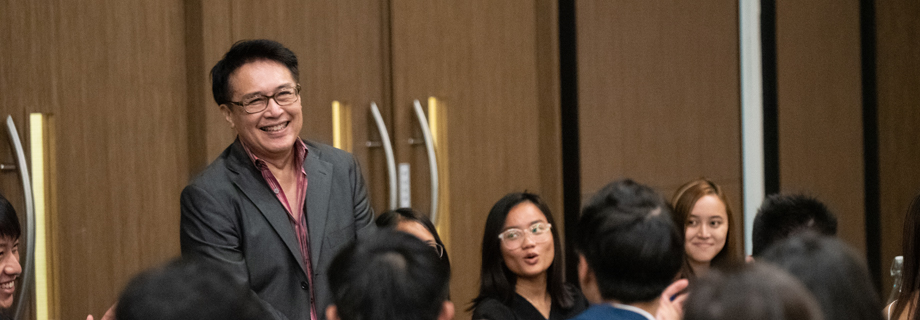Russel Wong is the first Singaporean photographer to break through Hollywood. He has photographed many celebrities, even politicians and creatives, from the East to the West, from Anthony Bourdain to Zhang Ziyi. To date, his portraits have graced 17 covers of Time magazine. Lisa Chin interviews the photographer for Tembusu’s Inaugural Dinner for Academic Year 2019/2020.
Can you tell me more about what you are doing now?
I’m usually on a whole bunch of projects at any point in time. Right now, I’m working on a coffee table book on geishas from Kyoto. I’ve been doing this project for about ten years now—it’s a passion assignment. I’ve been going to Kyoto quite a bit, documenting the life of these geishas, like the procedures and festivals. I just want to show this because many people do not get to see these.
I have also just finished my architecture show. It closed this week at the Japan Creative Centre. It’s on Tange’s architecture, Kenzō Tange, and his son Paul Tange. Both father and son designed the UOB Plaza and the Indoor Stadium. I photographed the buildings they designed because the Olympics is coming soon. Kenzō Tange designed the National Gymnasium for the 1964 Olympics while his son designed the 2020 Tokyo Olympics Aquatics Centre. So the father and son are quite prolific. Kenzō is pretty much an icon in Japan because he brought modernism to post-war Japanese architecture. He’s like the godfather of modern architecture in post-war Japan. We did the show, exhibited the buildings—that just finished.
Ongoing, I’m doing a lot of ads, a lot of photoshoots for Raffles Hotel since it just opened. So that’s a client of mine. I’ve been shooting all the famous chefs they have, some interiors, but mainly portraits of the people who have been involved. It’s ongoing.
I’ve also just finished the Guo Pei catalogues. I did all the catalogues, all the billboards, all the publicity. But mainly the catalogues being sold now. It’s in the museum now. It’s at the ACM until mid-September.
I’m looking forward to and hoping I’ll get involved in the sequel of Crazy Rich Asians since I was involved in it and there are two sequels, the second and third book. The next shooting is supposed to happen next year. So I did all the pubs for the first one—all you see for the first. I was also involved in the production, giving the producers information about Singapore. They bought the book about six years ago. The cameo was a big surprise for me because I don’t really act, but they got me to do it, because I’m mentioned in the second book. So it’s whether or not the scriptwriters choose to write me in. But I’m more concerned with doing the publicity for the second and third movie as well.
Where do you think the photography industry is headed to in Singapore?
I think it’s gonna evolve just like anything, and it’s already evolved from the time that I started. You know, I think people need to be more specialised. Nowadays, everyone is shooting everything and competing with everyone. [Like in zone where all the masses are.] So what I do is a bit more specialised, a bit more crafted, more nicely produced. I would say crafted is the word because I am trained. I am trained with a degree in photography. I am trained to shoot anything that is in front of me, and I am trained to do it in a proper way. Not just use a computer to correct stuff and use photoshop half the time. Because I think once you work on your craft alone, things will be fine. Nowadays, people shoot on both stills and videos, and clients like that. So maybe that is another direction people should consider. To do stills, you should still dabble in video. Because you see social media these days, on Instagram and Facebook, there are both photos and videos. Yeah, so you can’t run away from that. I used to do stills only, but if you can do a video element, it expands your horizons and you can shoot for more people.
But I think this advice is for people to still work on their craft—whether as a filmmaker or videographer—to do it properly and still get some training. Just experiment so you can grow. It’s not just about shooting on your handphone. You need a proper camera and proper equipment. Now it’s cheaper to get—so yeah.
Do you have any other advice for aspiring photographers?
Never stop shooting, never stop playing around with the camera—shooting, editing, playing with stuff. I think it’s never-ending, you know, so you can grow and learn. So that’s what I do; I never stop shooting. Even when I’m working and I’ve got work, I’m relentlessly trying to work at my craft again, refusing to be in the safe zone which doesn’t grow you. For me, I need to travel, and I travel a lot, and this helps me grow in my work. It moulds my style. So I’m open to a lot of things, I go to a lot of things, a lot of events to really help me grow and absorb what I see other people do—not necessarily other photographers. Because if you don’t grow as a person, your work won’t grow. It’s like they feed off each other.
This article is part of a series of interviews of Singapore’s cultural icons who were guests for Tembusu’s Inaugural Dinner for Academic Year 2019/2020. See the other interviews here.
Header and feature images by Malcolm Fu.
—
About the interviewer
If Lisa Chin is not cheering at the mats outside FairPrice, you’ll probably find Lisa in her room or a lounge studying/crying in stress because c’est la vie de l’ingénieur (it sounds more romantic in French).





